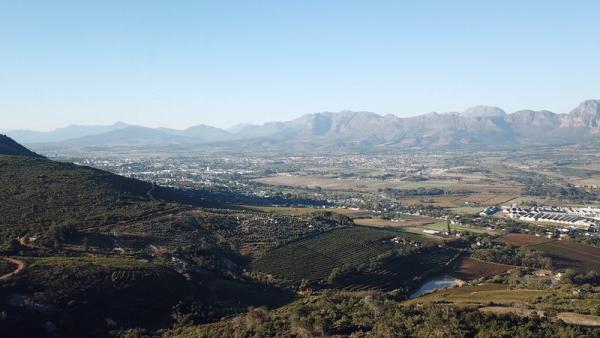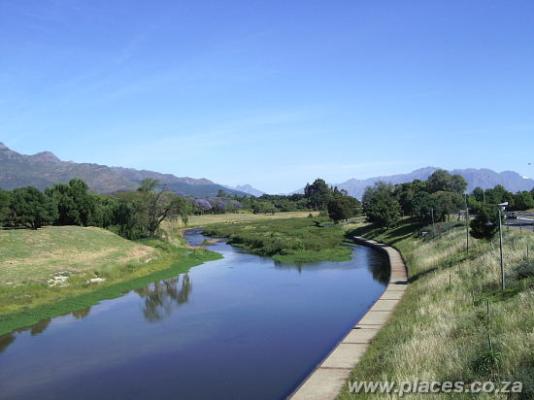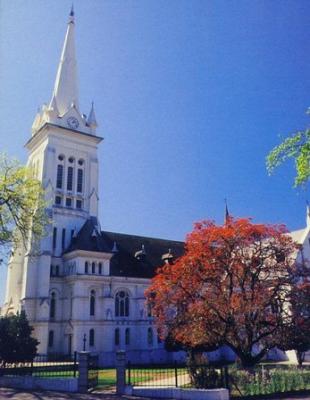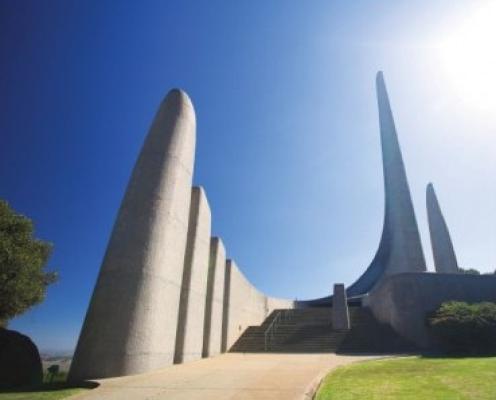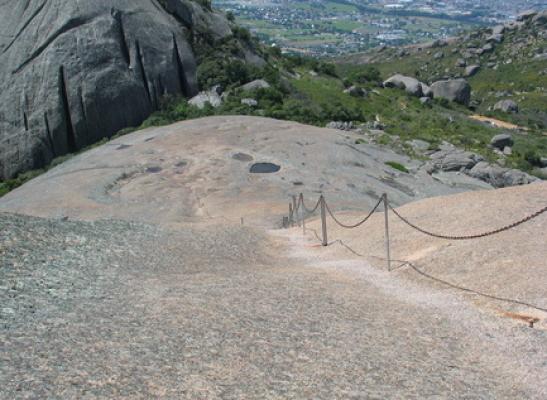Paarl, a mere 60 kilometers from Cape Town and less than an hour by car from the golden beaches of the Indian and Atlantic Oceans, is renowned not only for its illustrious past and unrivaled scenic beauty, but also presents holiday makers an exciting tourist destination. Its is one of the oldest towns in South Africa and particularly known for its mountain or "Paarl Rock". The huge granite rock is formed by three rounded outcrops that make up Paarl Mountain and is the second largest granite outcrop in the world.
The town boasts a unique attraction in the fact that the foundations of a new language, Afrikaans, combined heritage of Africa and the European mother countries, were laid here. The Monument to the Afrikaans language on the slopes of Paarl Mountain, the Language Museum and the Afrikaans Language Route through Dal Josaphat are living memorials to this achievement.
Paarl's scenic splendour, with five mountain passes and magnificent surroundings, the Berg River majestically winding its way through and bringing life to deciduous fruit orchards and vineyards right up to the heart of the town, and luxuriant vegetation, provide sufficient incentive to pay Paarl a visit. Add to this the rich heritage of well preserved historic buildings scattered through the town, the large number of top-quality restaurants offering traditional Cape cuisine, accommodation for tourists in hotels and on farming estates, and the inevitable wine industry - and you no longer have an argument in favour of visiting Paarl but an obligation to do so.
As far as the Wine industry is concerned, Paarl boasts the headquarters of the industry in South Africa, the co-operative Wine Growers' Association (KWV) and the Paarl wine route. The KWV is a South African institution that over the years has acquired an international reputation because of its unique achievements and its imprint of quality on the industry.
Paarl Mountain Nature Reserve
Paarl is particularly known for its mountain or "Paarl Rock". The
huge granite rock is formed by three rounded outcrops that make up
Paarl Mountain and is the second largest granite outcrop in the world
and forms part of the Nature Reserve.
Few towns have been blessed as Paarl has with an area of unspoiled natural beauty at its doorstep.
The
picturesque landscape of fynbos vegetation is dominated by massive
rounded granite rocks set among ancient wild olives, rock candle woods
and wagon trees.
The water in the storage dams contributes to the
tranquillity. There are several viewpoints which offer panoramic views
toward Table Mountain and the sea in the west and the Boland Mountains
in the east.
A network of paths make it an ideal area in which to walk, within a few minutes of the bustle of everyday urban life.
Local
schools have laid out the Klipkers Nature Trail for which a guidebook
is available. The circular route starts at the Language Monument and
takes roughly 2 hours.
Conservation of the indigenous plant and
animal life involves among other things, eradicating exotic plants and
implementing a program of controlled burning.
The Jan Phillips
Mountain Road is kept in good repair, although not tarred, as well as
the road leading to the Bretagne Rocks with its spectacular viewpoints.
On
the plateau, roads are not intensively maintained, mainly to discourage
motor traffic and to retain it as an unspoiled walking area.
Paarl Wine Route
The Paarl Wine Route is also called the 'Red Route' for its legendary red wines.
Cabernet
Sauvignon, port and Shiraz wines have established Paarl's place on the
global wine map and the region has repeatedly received international
awards for these wines.
The Paarl wine district lies to the north
of Stellenbosch, and is bordered by the town of Wellington to the north
east, and the mountains of the Groot and Klein Drakenstein and
Franschhoek ranges to the south east.
The Berg River, which rises
in the high mountains overlooking Franschhoek, winds its way to the sea
through an ever widening valley, flanked by the majestic Groot
Drakenstein and Wemmershoek Mountains, on through Paarl and past
Wellington.
This is the life giving artery of one of the
country's major wine producing areas. The most important areas situated
along the upper reaches of the river are: Franschoek, Groot Drakenstein
and Paarl.
There are three main types of soil in the Paarl wine
district: along the Berg River, which runs through the town of Paarl
from the south to the north of the eastern sector, the vines are grown
on the sandy soil of Table Mountain sandstone; on the mountain slopes
around Paarl and in the south east the soil is decomposed granite; and
in the north east it is Malmesbury shale.
The pH content in the
soils of the Paarl district is low, as it is in Stellenbosch, and deep
ploughing with liberal application of the agricultural lime is necessary
during soil preparation.
The valley land requires supplementary
irrigation in the hot growing season before the harvest, but vineyards
on the eastern slopes, having better water retention, frequently need
none at all.
The wine estates and cooperatives that are members
of the wine route arrange tours for visitors and provide an opportuity
to get to know the wine makers personally, to taste the wines and to
purchase some of the excellent and great variety of red and white wines:
Wine cellars on the route are:
African
Terroir, Anura Vineyards, Ashanti, Avondale, Backsberg Estate, Bernheim
Winery, Boland Kelder, Coleraine Wines, De Zoete Inval Estate, Domaine
Brahms, Fairview Estate, Frost Vineyards, Kleine Draken, KWV
International, Laborie Estate, Landskroon Wines, Nederburg, Nelsons
Creek Wine Estate, Perdeberg Co-op, Rhebokskloof Estate, Seidelberg Wine
Estate, Simonsvlei, Vendome Wine Estate and Windmeul Winery
Paarl History
Paarl is the third oldest European Settlement in South Africa. Today it
is home to a very culturally diverse community, the product of its
unique history. The people of Paarl are descendants of the
Khoisan, African-, and Eastern slaves, Dutch, French Huguenots, Jewish
immigrants from Eastern Europe, Italian Prisoners of War, and Xhosa
migrant labourers.
Khoisan The Khoikhoi and
San were the first people to utilize this area. San rock art can still
be seen at nearby Wemmershoek and Bainskloof.
What is today known as Paarl Mountain, used to be called Tortoise Mountain by the Khoikhoi.
The
Berg River Valley formed the traditional border between the Peninsular
Khoikhoi (the Gorachoqua and the Goringhaiqua) and the Cochoqua. The
latter group moved their cattle around the various grazing areas of the
Berg River- and Drakenstein Valleys.
The Cochoqua was one of the
richest and strongest of the Khoi tribes and had between 16 000 and 18
000 members. The Cochoqua were defeated during the second war between
the colonists and Khoikhoi and most of their livestock were looted.
After
the deaths of their leaders, the rest of the tribe dispersed. Some
trekked towards the Orange River and others started working for the
colonists.
European settlersThe Dutch:
The
original purpose of the Dutch settlement in the vicinity of latter day
Cape Town was to provide fresh food and water to the ships of the Dutch
East India Company, on their way to the East. Jan van Riebeeck built up
fresh meat stock by bartering livestock from the local Khoikhoi.
In
1657, Abraham Gabbema led an expedition, to find more Khoi groups to
barter from and to search for the legendary treasures of Monomotapa. On
the day that they arrived in the Berg River Valley, the granite
boulders, towards the west side of our town, glistened in the sun after
some showers. This inspired Gabbema to promptly name this mountain the
Diamond and Pearl Mountain from which the name Paarl was later derived.
In
October 1687, 30 years after the Gabbema expedition, Governor Simon van
der Stel granted the first farms to free burghers. Twenty-one of these
farms were in Drakenstein (Paarl), and five of them were at the foot of
Paarl Mountain.
The French
In 1688, the French Huguenots arrived in the Cape and some of them were given property in the Drakenstein area.
One
of their most important influences was of course their knowledge of the
wine industry. Today the headquarters of the South African wine
industry, the KWV, is to be found in Paarl. It is situated on one of the
earliest farms (La Concorde, as it is known today) to be granted by
Governor Simon van der Stel.
Conflict The
European idea of private land ownership clashed with the traditional
communal land use of the Khoikhoi. The farms that were granted to the
free burghers and Huguenots, used to be grazing for the livestock of the
Khoi.
Access to water also became limited and the wild animals that used to be hunted by die Khoisan quickly became scarce.
European
diseases, such as small pox, further decimated the indigenous peoples.
Many of the Khoisan were forced to move into the interior or became
labourers, working for the colonists.
The Slaves Between
1658 and
1808 63 000 slaves were imported to South Africa from many
different parts of the world such as Gambia, Nigeria, Angola,
Mozambique, Madagascar, India, Ceylon (Sri Lanka), Indonesia, Batavia
(Djakarta) and the Spice Islands.
Slaves had to sow, harvest,
and thresh the wheat. On wine farms, they had to harvest and press the
grapes. Slaves also had to load wagons, weed their owner's fields, and
look after the farmer's livestock.
The women did housework and
in some cases acted as wet nurses for their owner's children. In the
country female slaves also had to work as farm labourers.
Het
Gesticht (a a small unbaked brick church) was built in 1813 to provide
slaves with a place of worship. From 1820, onwards it became known as
the Zion Church. Het Gesticht is the fourth oldest church building in
South Africa amd located in Main street close to the Strooidak Church.
After
the slaves were emancipated in 1834, the freed slaves in Paarl received
some property in the vicinity of Berg and the later School Streets.
Paarl Annual Events
As befits a town with a long and colourful history, Paarl annually offers a variety of attractions which have already established a local tradition.
With
its abundance of sunshine in summer and water in winter, one would
rightly expect many of these attractions to centre on sport and
argricultural activities. And the large variety of
Paarl Accommodation options, make it easy for visitors to stay over and attend.
Paarl
indeed has no shortage of sporting facilities and, on behalf of all its
inhabitants, provision is made for athletics, cycling, rugby, cricket,
tennis, badminton, hockey, netball, swimming, jukskei, judo, karate,
bowls, golf, table tennis, squash and archery.
One of the
most important events of the South African social calendar is the
annual Nederberg Wine Auction. Scheduled for April, the Auction attracts
wine merchants, collectors and socialites from all over South Africa,
as well from overseas.
The Auction has become much more than a
wine auction; it has developed into a highly enjoyable carnival with a
fully-fledged fashion parade, interesting food and wine stalls and the
opportunity to taste South Africa's top wines.
Every year in
July, when the Cape is wet and the river flows strongly, hundreds of
canoeists set forth from Paarl on one of the country's greatest and one
of the world's most demanding canoe races, the Berg River Canoe
Marathon.
The distance of more than 200 kilometers is completed in four successive days.
It
is an unforgettable experience to accompany the canoeists on their
frequently bitterly cold and wet expedition and either as a helper or
spectator, to share in the fun at the overnight stops and the
spectacular finale when the race ends at Velddrift of the West Coast.
A
number of agriculturally based events and shows yearly offers
exhibitors and spectators alike a glimpse of the leading role played in
agriculture by the Winelands area - cheese festival, agricultural show,
etc.
The annual duel between two of the Western Cape's top rugby
schools, "Bois-haai" (Paarl Boys High School) and "Gimmies" (Paarl
Gymnasium High School), as they are colloquially known, takes place in
the first week of August in a test atmosphere.
Old Boys meet each other in a curtain raiser event, a big brag is held and a champagne breakfast arranged.
The
Winelands Classic Golf Tournament is one of the top amateur tournaments
in the country and is highly rated by golfers who have played on the
Paarl Golf Club's magnificent course on the banks of the Berg River.
Top
athletes and cyclists from all parts of the country participate every
year in the Boxing Day Sport Event and spectators flock in from the Cape
Peninsula and elsewhere to make of the day an unforgettable family
outing.
Each year in February/March students of the College go
into the streets of Paarl to collect money for local charity
organisations.
The carnival parade consist of Drum-majorettes, Brass Marching Bands and students dressed up to the theme of the Carnival.
Paarl Architectural Styles
Paarl is considered a treasure chest of South African architecture.
The
development of Paarl from its earliest times to today is reflected in
the variety of architectural styles contained in its Main Street.
They
range from the earliest Cape Dutch through to the elegant English
styles, from the ornamental Victorian, to Art Deco giving the street its
unique character.
Some of the most interesting buildings are:
Strooidakkerk (Thatched Roof Church)In
1687 the first grants were given to German, Dutch and French settlers
in the Paarl area but it was only after 1717, when the church was
established here, that the town itself started developing rapidly.
Not withstanding its great simplicity, the interior of this church is exceptionally dignified.
The churchyard adjacent to an attractive garden encloses the biggest collection of gabled burial vaults in the Western Cape.
Zeederberg SquareMany
artisans and merchants settled in between the farms along the 11 km
stretch of Main Road - the longest Main Road in the country.
After
1806 the architecture was influenced by the British style of building
which favoured larger windows, double storey buildings and slate roofs.
Many Cape Dutch homes were converted to express the new fashion.
The
latter half of the 19th century heralded major commercial development
in Paarl. At the same time the flamboyant Victorian style became
popular.
This is typified by the verandahs with their intricate
cast-iron decorations, corrugated iron roofs and plaster mouldings. Once
again the facades of many houses were changed.
Press BuildingDescribed
as a "Dutch Renaissance Revival" building and built in 1897, it has the
intricate detail of an important Victorian building - decorative
gables, Welsh slate roof, turrets and balcony.
Another feature is the white painted outlines of the bricks on a red background.
Zion ChurchZion
Church was completed in 1842 after lengthy money-collecting schemes
which even included collecting in England. It was restored in 1983 and
is once again being used as a church.
191 Main StreetThis
gabled house dates back to 1790 and has typical yelow-wood ceiling and
doors, thatched roof, casement windows and green shutters.
Town HallThis
imposing building was completed in 1928. The clean lines are
accentuated by the pediment and bell-tower. The pillars are made of
local granite and the whole building is painted white in contrast to the
darker background of Paarl mountain.
The Oldest BuildingAs far as is presently known, Bethel in Mill St is the oldest surviving building in Paarl.
Reference
to the house dates back to 1710 and the floor plan has not been altered
since 1756, although the facade was later altered to attain a Victorian
look.
Church BuildingsAmong the other attractive
church buildings in Paarl are the historic Holy Trinity (Anglican)
Church in Main Street, the St Petri Lutheran Church in Mill St, the old
Zion Church in Zion St, the Jewish Synagogue in Synagogue St, the Muslim
Chapel in Breda St and the Toringkerk in Main St
The Old Parsonage (Ou Pastorie)The
Old Parsonage in one of the most significant architectural treasures of
Paarl. This building, situated below the impressive Tower Church
(Toringkerk) in Main St, was completed in 1786.
It houses the Paarl Museum including an exceptional collection of Cape Dutch furniture and Cape silver and copperware.
La ConcordeThis
impressive building in Main Street, head quarters of the KWV, was
completed in 1958 and stands on one of the first five farms within the
present urban area of Paarl, granted to the French Huguenots by Simon
Van Der Stel.
Other buildingsScores of other
noteworthy houses and farms are to be found in Paarl district. The
homestead at Nederburg was built in 1800 and was, until recently
altered, the only historical house in the Cape which had survived
untouched and undamaged.
In De Jongh's Lane are three fine
examples of Cape-Dutch buildings and Rozenfontein in Main St possibly
dates back to the mid-19th century.
Het Gesticht in Main St,
Goedeverwachting, Huis Verening, the old WP Bank as well as the Laborie
Homestead are among other buildings in Paarl worthy of a visit.
Other Attractions
- Paarl Mountain Nature Reserve, especially
noted for the enormous 500 million year-old granite rock (Paarl,
Bretagne & Gordon) that gives Paarl its name.
- The Afrikaans Language Monument, on the slopes of Paarl Mountain and the Afrikaans Language Museum situated in the town.
- Treasure house of South African architecture along a 2 km stretch of the Main Street.
- The Paarl Museum is a must for its Cape Antiques and contemporary exhibitions of Paarl.
- The Ikhwezi Centre is the home to Bhabhathane weavers and artists from Mbekweni.
- In the Arboretum there are 700 indigenous and exotic species of trees. A
footbridge across the Berg River gives access to paved walkways on the
river bank.
- The Bird Sanctuary along the banks of the Berg River
features 136 species of birds. Species include the beautiful Malachite
Kingfisher, Maccoa Duck, African Marsh Harrier & African Fish eagle.
- Le Bonheur Crocodile Farm
- Butterfly World
- Lion Park
